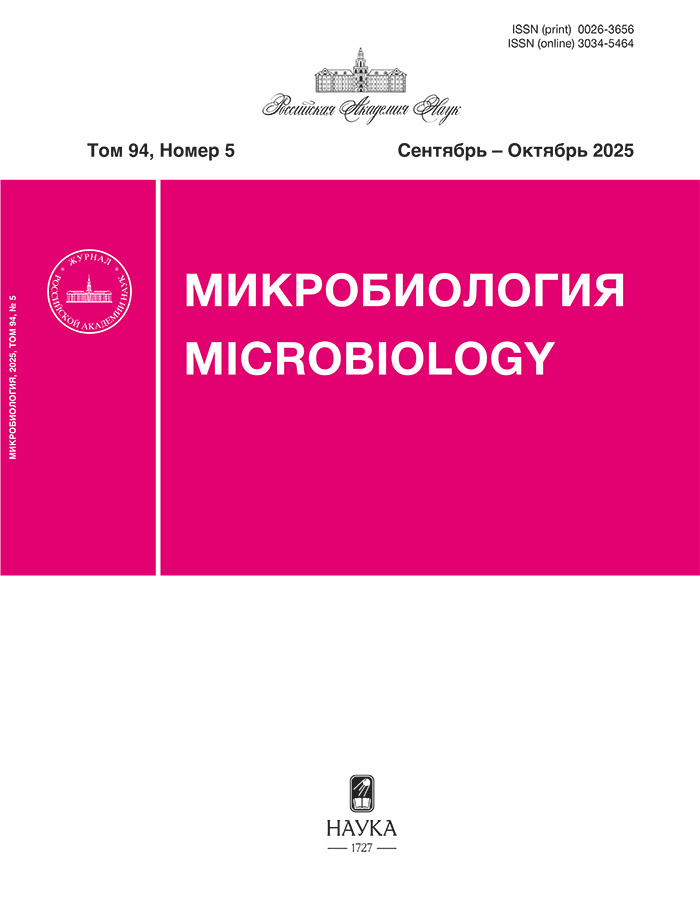Rhоdococcus qingshengii GIMm1 как основа биосенсора для определения фунгицида карбендазима
- Авторы: Кувичкина Т.Н.1, Капаруллина Е.Н.1, Доронина Н.В.1, Решетилов А.Н.1
-
Учреждения:
- ФИЦ “Пущинский научный центр биологических исследований РАН”, Институт биохимии и физиологии микроорганизмов им. Г.К. Скрябина РАН
- Выпуск: Том 93, № 2 (2024)
- Страницы: 145-148
- Раздел: КРАТКИЕ СООБЩЕНИЯ
- URL: https://kazanmedjournal.ru/0026-3656/article/view/655125
- DOI: https://doi.org/10.31857/S0026365624020086
- ID: 655125
Цитировать
Полный текст
Аннотация
Исследована возможность использования штамма Rhоdococcus qingshengii GlMm1, выделенного из образца глины Мертвого моря, как основы биосенсора для определения бензимидазольного фунгицида карбендазима. Наблюдали высокую чувствительность биосенсора от 2 до 160 мкМ карбендазима при нейтральных значениях рН и концентрациях NaCl до 500 мМ с долговременной стабильностью до 30 сут.
Полный текст
Об авторах
Т. Н. Кувичкина
ФИЦ “Пущинский научный центр биологических исследований РАН”, Институт биохимии и физиологии микроорганизмов им. Г.К. Скрябина РАН
Email: lenokap80@gmail.com
Россия, Московская область, Пущино, 142290
Е. Н. Капаруллина
ФИЦ “Пущинский научный центр биологических исследований РАН”, Институт биохимии и физиологии микроорганизмов им. Г.К. Скрябина РАН
Автор, ответственный за переписку.
Email: lenokap80@gmail.com
Россия, Московская область, Пущино, 142290
Н. В. Доронина
ФИЦ “Пущинский научный центр биологических исследований РАН”, Институт биохимии и физиологии микроорганизмов им. Г.К. Скрябина РАН
Email: lenokap80@gmail.com
Россия, Московская область, Пущино, 142290
А. Н. Решетилов
ФИЦ “Пущинский научный центр биологических исследований РАН”, Институт биохимии и физиологии микроорганизмов им. Г.К. Скрябина РАН
Email: lenokap80@gmail.com
Россия, Московская область, Пущино, 142290
Список литературы
- Китова А.Е., Кувичкина Т.Н., Аринбасарова А.Ю., Решетилов А.Н. Деградация 2,4-динитрофенола свободными и иммобилизованными клетками Rhodococcus erythropolis HL PM-1 // Прикл. биохим. микробиол. 2004. Т. 40. С. 307‒311.
- Kitova A.E., Kuvichkina T.N., Arinbasarova A.Y., Reshetilov A.N. Degradation of 2,4-dinitrophenol by free and immobilized cells of Rhodococcus erythropolis HL PM-1 // Appl. Biochem. Microbiol. 2004. V. 40. P. 258–261.
- Кувичкина Т.Н., Будина Д.В., Олькова А.С., Решетилов А.Н. Оценка присутствия ди-(2-этилгексил)фталата в поливинилхлоридных пластикатах масс-спектрометрическим и биосенсорным методами // Теоретическая и прикладная экология. 2015. № 4. С. 11‒15.
- Патент на полезную модель 2015. № 156 546.
- Belova A.A., Kaparullina E.N., Agafonova N.V., Grouzdev D.S., Kopitsyn D.S., Machulin A.V., Doronina N.V. Ancylobacter crimeensis sp. nov., a new species of aerobic methylotrophic bacteria isolated from Oak phyllosphere // Microbiology (Moscow). 2023. V. 92.P. 598–608.
- Fang H., Wang Y., Gao C., Yan H., Dong B., Yu Y. Isolation and characterization of Pseudomonas sp. CBW capable of degrading carbendazim // Biodegradation. 2010. V. 21. P. 939–946.
- Pande G. Domian S.J., Russell R.J., Brearley C., Kotsonis S., Cakeshott J.G. Cloning and biochemical characterization of a novel carbendazim (metyl-1H-benzimidazol-2-ylcarbamate)-hydrolyzing esterase from newly isolated Nocardiodes sp. strain SG-4G fnd its potential for use ln enzymatic bioremediation // Appl. Environ. Microbiol. 2010. V. 75. P. 2040‒2945.
- Singh S., Singh N., Kumar V., Datta S., Wani B., Singh D., Singh K., Singh J. Toxicity, monitoring and biodegradation of the fungicide carbendazim // Environ. Chem. Lett. 2016. V. 14. Р. 317‒329.
- Xu J.L., He J., Wang Z.C., Wang K., Li W.J., Tang S.K., Li S.P. Rhodococcus qingshengii sp. nov., a carbendazim-degrading bacterium // Int. J. Syst. Evol. Microbiol. 2007. V. 57. Р.2754‒2757.
- Zhang M., Bai X., Li Q., Zhang L., Zhu Q., Gao S., Ke Zh., Jiang M., Hu J., Qiu J., Hong Q. Functional analysis, diversity and distribution of carbendazim hydrolases Mhel and CbmA, responsible for the initial step in carbendazim degradation // Environ. Microbiol. 2022. V. 24. P. 4803‒4817.
Дополнительные файлы













